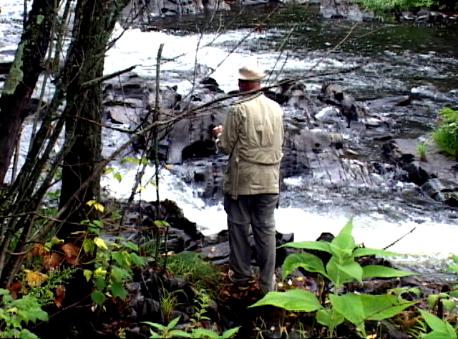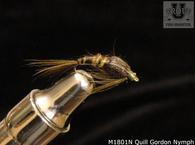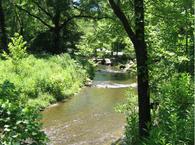
The Clyde River is over 25 miles (40 km) long and is a tributary of Lake Memphremagog in northern Vermont on the USA and Canadian border. We believe that it was named by an early Scottish surveyor who favored the more famous Clyde River in Scotland. It is a beautiful river interrupted by small dams resulting in small lakes and ponds as it flows through the beautiful Vermont countryside.
The Clyde contains a wide variety of water including sections of slow water and sections of fast water providing the habitat for an abundance of bait fish. This in turn is what enables the brook trout to flourish and grow large. The Clyde requires several different methods to adequately fish it with flies. One method is required for the small lakes and the slow moving water, another method will be needed for the fast waters and still another method with larger tackle will be required for the salmon runs.
The one and one half mile long stretch of water for landlocked salmon is located in Newport and extends from Lake memphremagog to the steep runs just below the Clyde Pond Dam. (Besides having too many syllables, it is interesting to note that the Lake is an Algonquin Indian name for large body of water.)
The Clyde upstream from this dam runs through a valley with several small ponds. Remember we said above that the Clyde offers a wide variety of types of water, well that includes a portion that flows through marshes and swampy areas containing both wild, and stocked brown and brook trout. The upper section of the Clyde above the lakes holds a good population of brook trout. Fished from a canoe, the angler has access to some deep holes that harbor large brook trout that can often weigh in over two pounds.
The Pherrins River is a tributary of the Clyde River, and it also has excellent brook trout fishing. These brookies trout can also grow up to a few pounds which are a bit unusual for brookies this far north.
Fishing the Clyde River:
The Clyde can be a challenge since it has so many different types of water. Select a 6 WT rod and include caddis and trico flies in your tackle box. When fishing for the salmon in the spring they will be feeding on smelt, and a streamer is in order. When fishing the upper portions in and near the Pherrins River for brook trout; small dry flies are the order of the day.
You probably should decide your strategy before getting to the Clyde River as you could not carry all the necessary gear, equipment and selection of flies for all conditions.
Spring:
The season opend in the middle of April and the Blue Winged Olives, the Quill Gordons and the Hendricksons should start to hatch on the warmer days. The smelt should be running and the salmon fishing will be good in that portion of the stream. However, you need to decide which species to pursue as the equipment needs as well as the fly requirements are different.
Summer:
The fishing remains good in the summer and the brookies are vulnerable to dry flies. Don’t forget to place some terrestrials in you fly box as well.
Fall:
The fishing season remains open for all of October, and fishing the river is especially good in the fall. It is artificial lures and flies only fishing and all salmons must be released. The scenery is special as well, so don’t miss the trip.
Easy access to all the different sections of the Clyde River is provided by SR 105 which follows the river for most of its length.
Fly Fishing for Small Stream Brook Trout
Fly Fishing Eastern Freestone Streams - Successful Strategies
Fly Fishing Strategies That Catch Trout
View New England in a larger map





